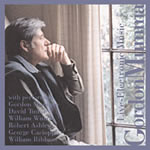|
|
 |
Dusted Reviews
Artist: Gordon Mumma Album: Live-Electronic Music Label: Tzadik Review date: Mar. 31, 2002 |

|
|
|
 |
Even though he’s often mentioned in the same breath as people like John Cage (for whom he built equipment) and Pauline Oliveros (with whom he collaborated), the importance of Gordon Mumma’s pioneering electronic work has never been fully recognized. It’s a shame, too, considering the depth of the man’s career – not only was he connected with Cage and Oliveros, but he also helped found the ONCE Festivals, worked with people like David Tudor and Anthony Braxton, and explored the connections between computers, acoustic instruments, and performance long before it was the hip thing to do. In short, he helped reshape modern composition and laid the groundwork for much of today’s contemporary electronic and avant-garde performance. And still, save for an article in a recent issue of the Wire, little attention has been paid to Mumma. With any luck, however, that will all change with Tzadik’s release of Live-Electronic Music, a newly issued disc that collects some of his most important pieces.
The record starts with the most current of the five pieces featured here, “Than Particle," a duo for acoustic and electronic percussion featuring William Winant. The piece shares the least common aesthetic ground with anything else that follows, but it’s intriguing nonetheless. Using an early synthesizer designed to imitate acoustic instruments, the duo weave a ten-minute long session buoyed by the solid work of Winant, but then shattered by the sometimes farcical imitations of the synth. The key here is the interplay of the two types of instruments – the very real sounds of percussion contrasted with the assumed realistic qualities of a synthesizer. Temporally, this is also the latest of the pieces, having been recorded in 1985. This makes for an even more interesting juxtaposition between the two types of instrumentation considering that at the time most popular musicians experimenting with synthesizers were doing their best to get away from the sounds generated by conventional acoustic instruments.
“Hornpipe”, however, is a much different piece entirely. Using a waldhorn, a valve-horn, and cybersonic devices of his own invention, Mumma unleashes wave after wave of mutated horn sounds on the listener. The method to Mumma’s madness is best explained in this context by examining his rationale for the term cybersonic – “cyber” coming from the Greek work “to steer” and “sonic” from the Latin for “sound”. The goal of his instruments, then, is based more in expanding the capabilities of conventional instruments in the space that surrounds them – to see what possibilities exist for the sounds of a horn for a particular performer. Mumma expertly stretches this notion out, employing a series of tones and bursts that retain their traces of conventional instrumentation while sounding completely of another world. “Horn” explores similar territory although with more sinister results. This time around, the piece adds voices to the mix, although the general concept remains the same – exploring how particular sounds relate to and influence each other. Each performance builds off its predecessor, allowing for the change and influence of one to permeate the walls of sound that are created.
While the other four pieces on this disc are stirring, it’s the twenty-two minute epic “Mesa” that is undeniably the centerpiece of this recording. With the assistance of David Tudor on bandoneon, Mumma uses his cybersonic techniques to overlap frequencies of the instrument, subsequently creating a mass of enharmonic tones, and ultimately a type of quadraphonic sound. Mumma toys with the spaces in between as much as be does the actual instrument itself, with each successive drone heightening the tension of the piece as the noises repeatedly build and collapse around the listener. At times it feels difficult but almost never forced, gracefully allowing the interplay of the two instruments and players to take center-stage, forming pieces of incredible sound that sound as fresh and vibrant today as they did over thirty years ago when they were recorded.
Perhaps the most striking thing about the disc is that despite the thirty-odd years since the earliest compositions, it still sounds relevant. Undoubtedly this is music that would fit very comfortably in the stacks amongst the best of today’s experimental electronic music. Given the extreme propensity for sound-alike IDM producers these days, this may not sound like a complement, but Mumma’s work’s refusal to sound dated shows just how far ahead of the curve he really was. With at least two more retrospective sets along the way, and additional new recordings slated for release sometime this year, it’s good to see Gordon Mumma poised to reap some of the acclaim he so richly deserves.
By Michael Crumsho
|







